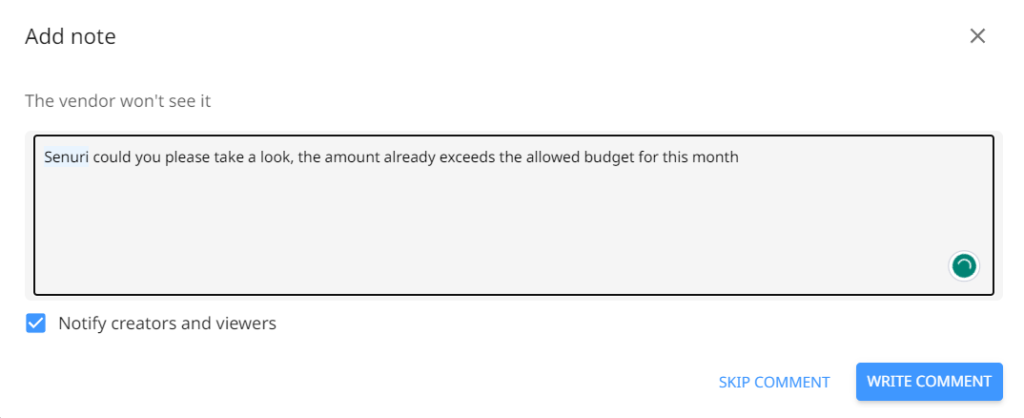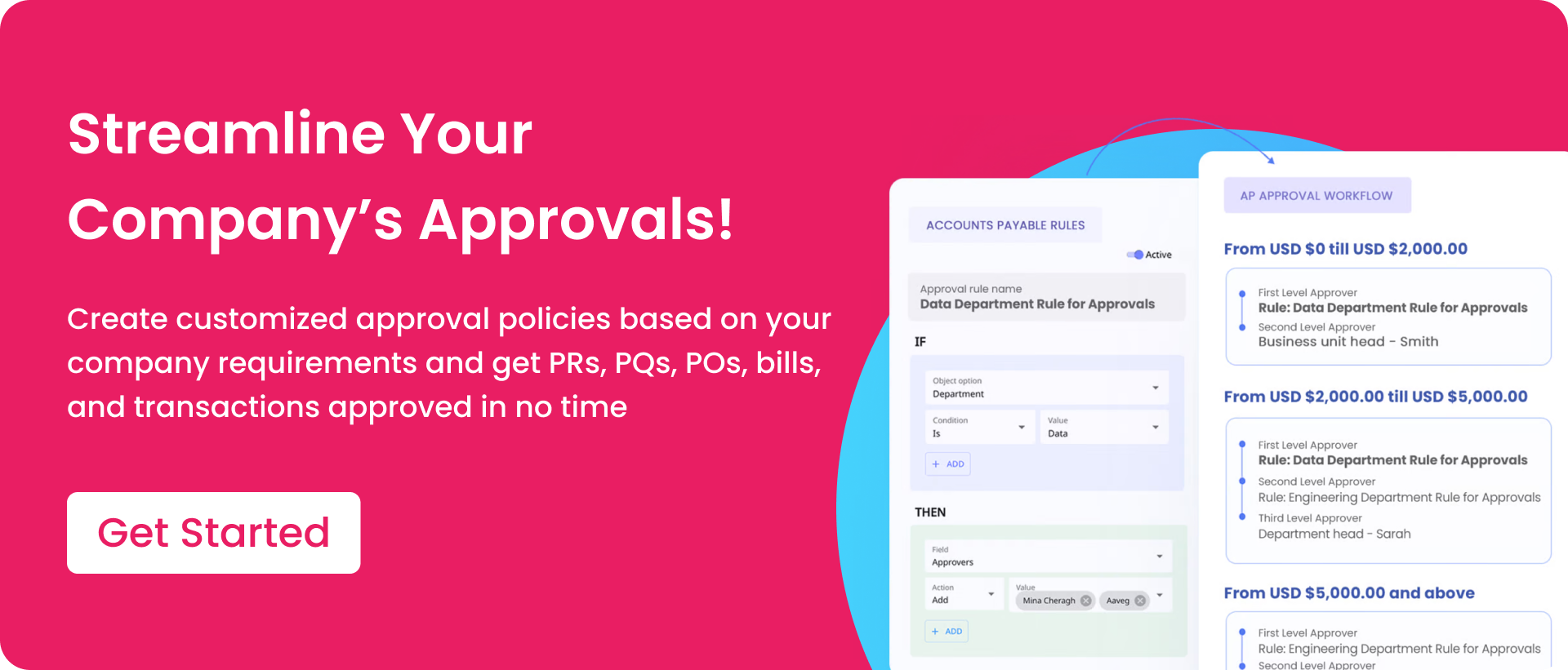All transactions in a business require approvals. However, a lot of companies have a hard time managing their approval workflows.
The approval process can be highly complex. In a medium to large business setting, approvals may require the involvement of numerous stakeholders from different units and teams.
So, how do these departments control their approval workflows for transactions that vary in terms of amount, project, and stages? An approval matrix can be the solution.
In this article, we will discuss approval matrix meaning, its importance, and the solution to streamline your approval workflow through automation.
What Is an Approval Matrix?
The approval matrix represents a set of decision-makers in charge of a business process. This is to ensure that they’re adhering to the standards of operations.
An approval matrix clearly outlines the individuals responsible for approving specific tasks and the corresponding timelines. This helps avoid confusion in task delegation and ensures a smooth and efficient approval process.
The approval matrix consists of a route of approval flows based on business processes or projects. The decision-makers could range from department heads or managers to C-level executives.
Different scales or categories will have a different set of stakeholders that hold the approval. The matrix works in an “If x then y” formula to establish a clear regulation, which may vary based on the following:
- Amount of items
- Monetary cap
- Specified purchases
- Vendors and subsidiaries
For instance, an analyst would need their supervisor’s approval for a small amount of purchase. On the other hand, a larger purchase might need the approval of a manager or executive at a higher level.
Why Use an Approval Matrix?
Using an approval matrix template for your spending decision will be helpful as it enables your business to:
Gain Clarity over Spending: Ensure every expense stays on budget and is based on the established approval matrix, therefore standardizing the decision-making process.
Establish Accountability: The matrix establishes a chain of responsibility, making it easier to identify who is accountable for each approval. This helps in tracking progress and resolving any bottlenecks promptly.
Consistent Decision-Making: It promotes consistency in decision-making across different tasks or projects. This is particularly important for maintaining quality standards and aligning with organizational objectives.
Time Savings: An Approval Matrix can save time by preventing unnecessary back-and-forth communication and delays in the approval process. This is especially crucial for meeting deadlines and guaranteeing that spending decisions are made on time.
Enable Efficient Workflow: By specifying the approval process, it streamlines the flow of tasks and prevents unnecessary delays. This ensures that approvals are obtained promptly and tasks progress smoothly.
Avoid Confusion: With a designated approval matrix, there is less room for misunderstanding or uncertainty regarding approval procedures. Team members know exactly who to approach for approvals, eliminating confusion.
Types of Approval Matrix
The approval matrix does not only apply in the account payable process but also to other functions. Below are some of the primary types of approval matrix templates.
Purchase Approval Matrix
Purchasing approval matrix is an approval workflow for purchasing based on monetary value.
From the purchasing approval matrix template Excel below, the matrix illustrates a hierarchical route of approval from the Department Head up to the VP of Finance, depending on the amount of purchase.
| Type of Purchase | Purchase Cost (in million IDR) | Department Head | Business Unit/C-Level Head | Procurement Manager | Procurement Head | FAT Manager | VP of Finance |
| Ad Hoc Items | ≤ 3 | No approval needed | |||||
| Small | > 3 – 25 | ✓ | ✓ | ||||
| Medium | > 25 – 85 | ✓ | ✓ | ✓ | ✓ | ||
| Large | > 85 | ✓ | ✓ | ✓ | ✓ | ✓ | ✓ |
For instance, if the purchase request amounts to IDR 50 Million, The approval will have to go through the Department Head up to the Procurement Manager, along with the FAT manager.
The biggest challenge for some organizations is to manage approvals due to the multi-tier hierarchical structure. Especially if the company has different stakeholders that are spread across different departments and business units. The example is the table below.

To ensure a clear purchase approval flow, it’s best to break down the approval system on a department level, and then tag the stakeholders involved based on the business unit.
However, most organizations still handle this process of approval in a Spreadsheet, Excel, or manually – which is a nightmare. Using reliable accounts payable software with role-based controls will be the right solution for medium to large enterprises.
New Project Approval Matrix
A new project approval illustrates departments or teams responsible for specific projects. A project may require different departments based on the expertise needed, therefore requiring this kind of approval.
Unlike the purchase approval matrix, the new project approval matrix template does not depict any hierarchical or sequential workflow. Instead, it shows a parallel process, where several decision-makers examine a request simultaneously and come to an agreement.
| Chief Operating Officer | Chief Financial Officer | Chief Marketing Officer | Chief Technology Officer | Vice President | President | |
| Marketing/Advertising | ✓ | ✓ | ✓ | |||
| Product | ✓ | ✓ | ✓ | ✓ | ||
| Social Impact/Charity | ✓ | ✓ | ✓ |
Content Approval Matrix
The content approval matrix policy shows which stakeholders need to review and authorize the drafted content before being published. The workflow is also depicted as a parallel process and assigned based on expertise.
| Social Media Manager | Marketing Manager | Chief Marketing Officer | |
| Social Media Post | ✓ | ✓ | |
| Blog and Infographic | ✓ | ✓ | |
| Press Release | ✓ | ✓ | ✓ |
How to Automate the Approval Matrix to Streamline Finance Processes?
The approval matrix policy is helpful for your business as a guiding principle that identifies the required approvals workflow for different scenarios. Your business’ spending structure will be heavily influenced by the overall culture and practices in making expenditure decisions.
A good approval flow holds the stakeholders accountable for approving expenditures and streamlines the approval process. To support this, you’ll need a tool that you can depend on.
With Peakflo, you can customize and streamline approval workflow through our automation system. Fret not! We will guide you on how to create an approval matrix to ease your reimbursement or other transactional processes.
Create a Simple Approval Policy
Create approval policies for a range of departments in your organization and manage them in one dashboard. By default, Peakflo already has the default approval policy to ensure that all purchase orders, bills, transactions, and credit notes are tracked accordingly.

Adding a new policy is fairly simple with Peakflo’s intuitive setup wizard. Here, control the amount of expense based on the budget or policy, then assign the relevant approvers – up to multiple levels.
Manage the spending and approvers for departmental approval just in one workflow by simply adding brackets. Implement the policy for any use cases, such as bill and transaction approvals.

To fast-track the process, Peakflo also comes with auto-approval. This will only occur if the bill creator is the first-level approver. The process will immediately proceed to the next level of the approver.
Add Rules to Bypass Complex Approval Flows
If your business has a large and complex organizational structure, handling approvals might be more difficult.
For instance, your company has various departments under which there are several business units, led by different heads.
As a result, you will need to set hundreds of approval workflows to accommodate different levels of hierarchy, which can be tedious and not sustainable.
With Peakflo, you can simplify cross-departmental approvals by establishing approval rules.
Creating approval rules enables you to group approvers based on the specific business units, departments, budgets, and any other needs.
Utilizing the If x then y formula, you can add the conditional setting and the outcome. Let’s say you’re handling a marketing department, under which there are business units. In this case, set approvals based on those requirements, then control who will approve the transactions.

Instead of adding hundreds of users to the approval policy, simply add the rules you’ve set and you’re ready to roll.

Oversee Your Approval Process
All of your approval progress and status are centralized in one dashboard to provide you with real-time insights. This will make it easier for you to manage approvals and take actions such as following up with the approvers to clear up any pending items in the backlog.

By clicking on the bill, you’ll have access to the timeline filled with all the information you need, such as vendor details, payment amount, dates, budget source, etc. Most importantly, find out at which level the approval is pending.

For seamless communications, send the approvers an email reminder just with a click of a button.

Once opening the email, the approver will be directed to the pending bill and can access all the information complete with the audit trail. They can either decline or return it to draft in case there are any discrepancies, and keep everyone in a loop by leaving a note and mentioning them.

Takeaway
The approval matrix ensures that the system set in place follows the policies and standardized processes. It controls who can provide the approvals and is useful for many use cases, from managing transactions to projects.
The approval process itself can be deceivingly simple. In truth, some companies have more complex approval processes due to the organization’s hierarchical structure that spans different departments and business units.
Peakflo’s Approval Workflow Automation can hack into the approval flows, no matter how complicated they are, so you can focus on getting things done. Our customer, Rey, has accelerated the time they take for approvals by 60%, and you can achieve the same or even higher level of success with us.

Try out Peakflo to see how our features can transform the way you do business for the better.










![Why AI Sales Calls Are Making Good Sales Reps Even Better [2025 Guide] ai sales calls](https://blog.peakflo.co/wp-content/uploads/2025/09/65168cf6-3001-4733-8cbc-12d5684cf449-218x150.webp)





































